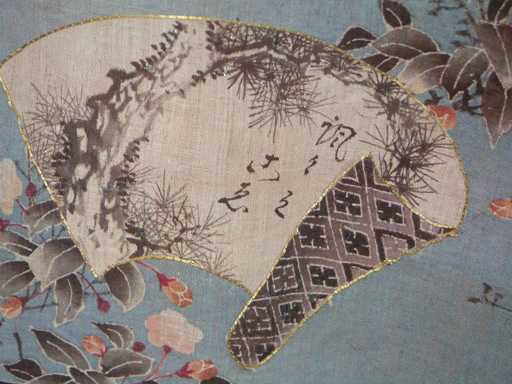Description
Museum quality Furisode dating to the late 1700s, Kanazawa Area
The combination of artistic efforts that were required to produce this exceptional Kimono took enormous time and labor. On this Furisode, a Kimono with long, swinging sleeves that could only be worn by an unmarried woman, the creative excellence goes beyond the original hand weaving, hand dyeing, hand painting, and hand embroidering, including the pure gold threads. It began with the weaving of the grass bast fibers known collectively in Japan as “Asa,” which include hemp, ramie, and the linen of this marvelous Furisode, which figured importantly as a ground for dyed and painted fabrics – luxury fabrics whose use was restricted to the wealthy aristocracy, who were only allowed by law to wear it in the summer months of June, July and August.
The natural indigo dyes that were used to create this exquisite Furisode are a spectacular example of “oboro-zome,” a skillful use of dye that results in a full range of shaded dyeing from white to grayish or indigo blue. The Indigo of Japan was more widely used than any other color, largely because it evoked a sense of freshness and coolness so welcome in the warmer months. Long life and good fortune are reinforced by the use of the varying shades of blue.
The artist created 10 individual Sumie Ink Fan Paintings around the hem and on the front and back of the sleeves with appropriate calligraphic notations or the artist’s seal . Each design is dominated by an Open Fan (“Ogi”) “) representing the young maiden’s open future. Each of the images goes a step beyond the “Tsutsugaki” or Rice Paste Resist process, a technique that required each color be applied separately, while all the others were painted out in the rice paste. Each time a new color was added, the rice paste had to be removed by soaking it out over and over again in the local river water. The Rice Paste Resist method of Yuzen, is a masterful and complicated method that builds on the Tsutsugaki process. It results in a distinguishing, thin white outline around each element in the design. This is an astonishingly difficult, time consuming, and labor-intensive process that could only have been accomplished by a very talented painter.
Each of the individual artworks within the fans was carefully chosen to symbolize what was important to the young woman who would wear this Furisode. Each holds an image that is recognizable: the Lobster (“Ebi”), an animal tied to New Year celebrations, also symbolizing old age and long life; Peonies (“Botan”), the flower of the Chinese Empress bringing with it the association of royalty; Grasses (“Kusa”), thought to be appropriate for goods used by women; several magnificent Pine (“Matsu”), revered as a tree of good fortune and long life since ancient times; Chrysanthemum (“Kiku”), the flower of the Imperial Family of Japan; the Mandarin Crane (“Tsuru”), a harbinger of long life and good fortune; Bamboo (“Take”), strong and resilient and when paired with the Pine and Plum represents the Three Friends of Winter; Mt. Fuji, the most revered and famous landmark in Japan; a decorated Ikebana basket with tea (“Cha”) cups indicating the esoteric and aristocratic nature of the Way of Tea expected to be an accomplishment of a young woman of royal birth; and the Crab (“Kami”), a majestic animal evocating the authority of the Samurai warriors.
All of these illustrious paintings are surrounded by clusters of Plum (“Ume”) branches generously covered with blossoms and buds and then embroidered, including the pure handmade gold threads “Couched” on the distinctive scenes. Pure gold threads were created by painting liquid gold on sheer handmade paper and then wrapping it around several strands of silk. Because it was so delicate, it was laid on top of the design and sewn down by hand.
The family’s crest (“Mon”), the symbolic design appearing on the upper center back and on the sleeves, appears 5 times and indicates that this was a Furisode intended to be worn for formal occasions. The crest is that of the Plum Blossom (“Ume”), signaling the significance of the Plum Blossoms surrounding each Fan. The Plum represents more than beauty; although it appears delicate and fragile, it arrives early in the year, braving the cold and signaling the end of winter. It is considered one of the “three companions of the cold.” It was actually practical as well as hardy and would definitely strengthen the theme of the Kimono’s design.
This Furisode illustrates the very best of Japanese artistic techniques appearing before the end of the 1700s. It could only have been commissioned by a very wealthy member of the nobility, and has happily survived as a valued heirloom.
A Certificate of Authenticity is included
TTAC will personally pack and ship via UPS at company expense within the continental United States.





















